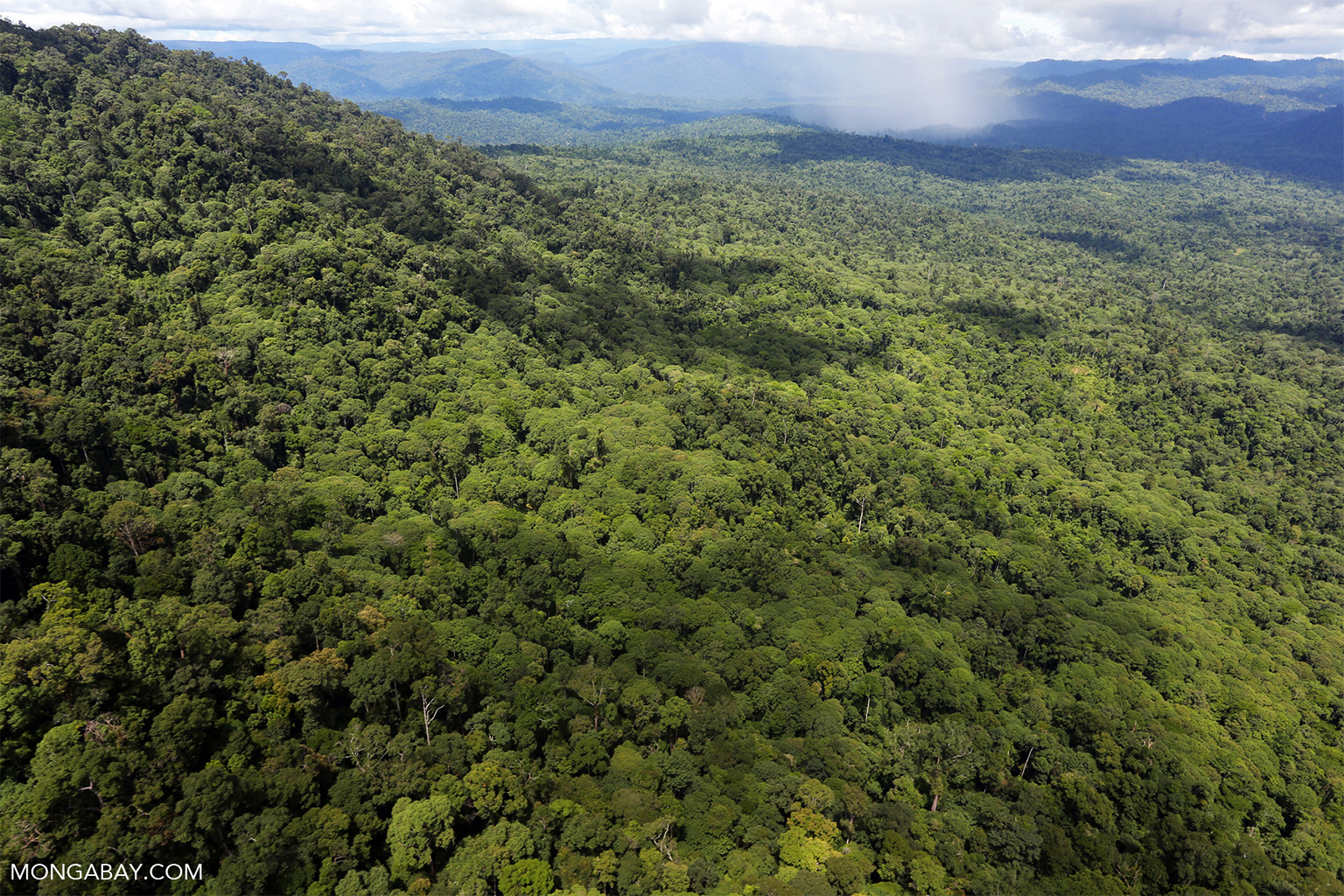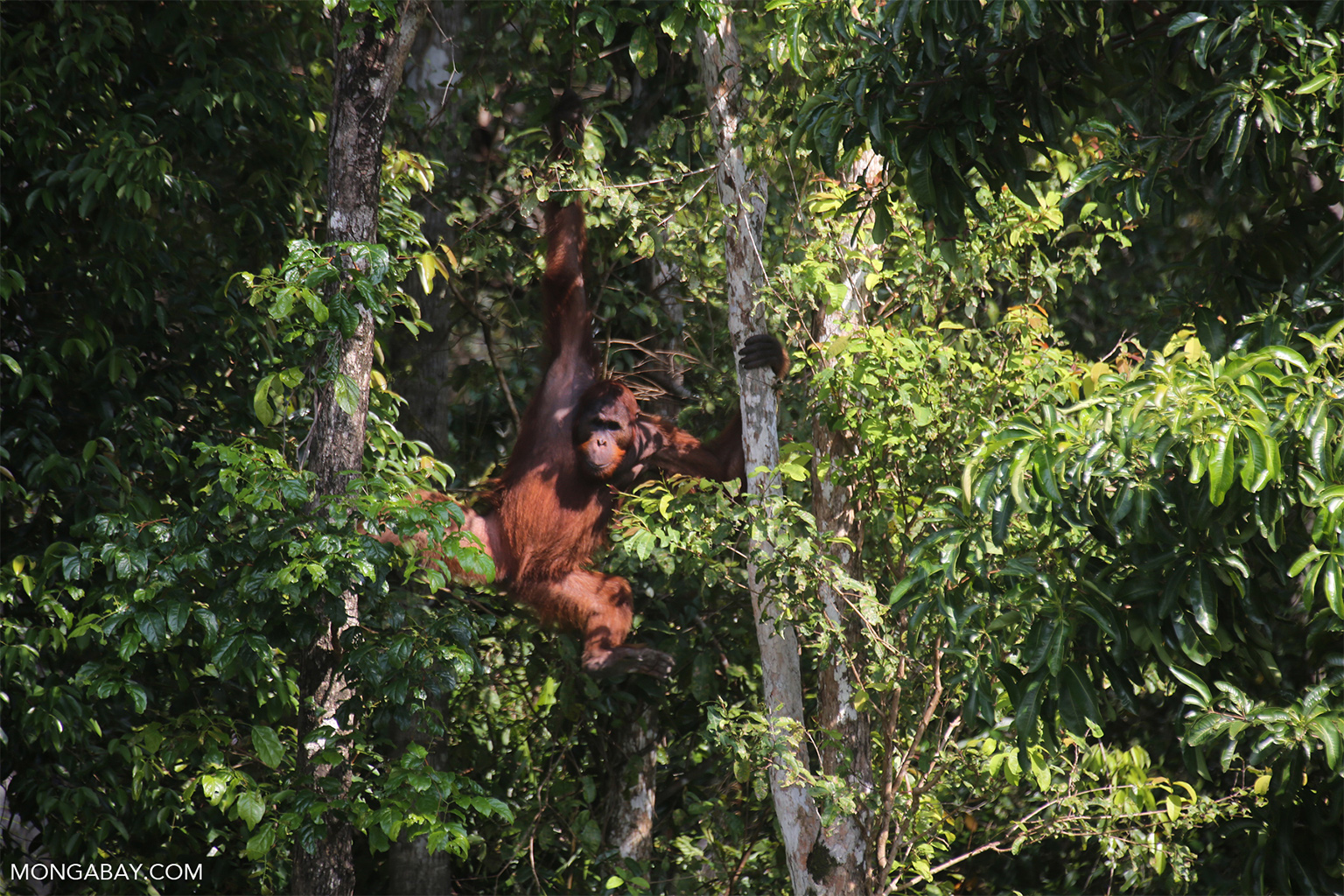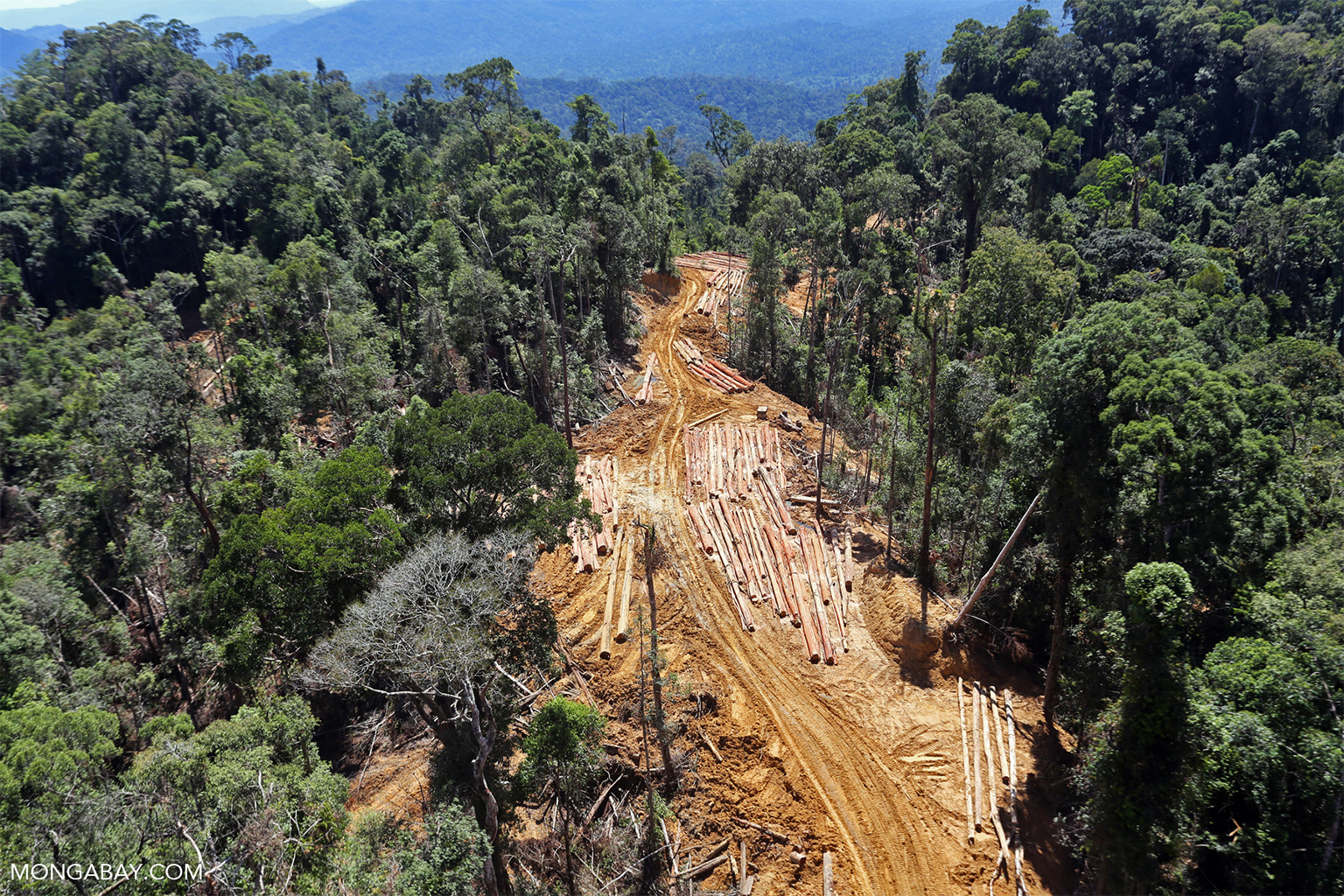- In a recent study, a team of researchers attempted to predict how the application of two global conservation ideas, Half-Earth and Whole Earth, would impact orangutan conservation on the island of Borneo in Southeast Asia.
- Numbers of all three species of orangutans continue to drop due to habitat loss and killing by humans, despite an estimated $1 billion spent on conservation efforts in the past two decades.
- The researchers surveyed orangutan experts about their thoughts on the application of the two ideas on Borneo; the resulting analysis predicts continued declines for Bornean orangutans under both Half-Earth and Whole Earth paradigms, though they report that the species would fare better under Half-Earth.
- Proponents of the Whole Earth paradigm argue that the authors of the study misinterpreted some of the idea’s central tenets, however.
Orangutans, like most of the world’s great apes, are struggling. Their numbers continue to drop as their habitat disappears, or they’re killed by humans for food, out of fear or for self-defense. And it’s happening despite an estimated $1 billion in spending on concerted orangutan conservation efforts since 2000. The ongoing slide has left biologists flummoxed about how to ensure the survival of the three species of the Pongo genus.
Now, the authors of a recent study have posited how two sweeping, global conservation ideas might impact orangutan survival: the Whole Earth and Half-Earth paradigms. In doing so, this thought experiment has surfaced questions about the impacts of these frameworks on the conservation of a single species, as well as about whether the authors accurately interpreted these frameworks.
In research published Oct. 13 in the journal Oryx, conservation scientist Erik Meijaard and his colleagues projected how the application of the Half-Earth and Whole Earth paradigms might change land use and the arrangement of protected areas on the island of Borneo between 2021 and 2032. The Half-Earth approach encompasses a collection of ideas centered on setting aside half the planet’s land and water areas for nature. The application of Whole Earth, in the view of the Meijaard-led team, would entail moving away from traditional protected areas and toward “a much more equitable system in which local communities decide what happens to their land,” Meijaard said.
The team then shared these projections with orangutan experts and asked them how they thought the resulting changes would impact numbers of the Bornean orangutan (Pongo pygmaeus). From their analysis of the responses they received, the authors concluded that orangutans would fare best under a Half-Earth scenario.


Conservation, in theory
Until now, Half-Earth and Whole Earth have remained “largely theoretical proposals,” said Meijaard, managing director at the Brunei-based consultancy Borneo Futures.
“I thought it’d be really interesting to see … what actually happens if you try to implement them,” he said, in this case, to the conservation of the Bornean orangutan.
For comparison with their Half- and Whole Earth projections, the team also speculated on what could happen if deforestation and the killing of orangutans continue at current rates from 2021-2032. They also mapped out a longer-term, “aspirational” scenario in which the problems of habitat loss and unsustainable killing were solved.
Collectively, the 24 experts who responded to the team’s questionnaires (out of a total of 63 contacted) predicted that Bornean orangutan numbers would decrease under all of the scenarios put to them except for the aspirational vision. In that case, the experts predicted the population would grow by nearly 150% over the next century.
Of the three other scenarios, the analysis predicts that a Half-Earth application in Borneo would lead to a 13% decline, while maintaining the status quo would result in a 25% loss of orangutans.
In principle, Meijaard said, a Half-Earth scenario already exists in the parts of Borneo where most orangutans live: A network of protected areas, along with timber concessions that are “exploited sustainably,” covers more than half of the Malaysian state of Sabah and Indonesia’s Kalimantan provinces.

Operators of the timber concessions must maintain them as natural forest, Meijaard said. “That doesn’t always happen, but that’s at least the idea behind them.”
Meijaard said the proportion of protected areas in Malaysian and Indonesian Borneo outstrips the share of protected areas in many more industrialized countries, even as leaders in the Global North have voiced support for such headline-grabbing targets. At the outset of the annual U.N. climate conference (COP27) on Nov. 7, leaders from six countries, including the U.S. and the U.K., added their support to the 30×30 target, which calls for 30% of the planet to be protected by 2030 and is seen as a stepping stone to achieving the Half-Earth goal.
Still, despite the protections in place in Borneo, Meijaard acknowledged that the continued decline of the Bornean orangutan reveals that more needs to be done.
“We have Half-Earth in place on paper,” he said, “[but] it requires better management.”

A ‘whole’ different story
Under the Whole Earth scenario outlined by Meijaard’s team, the experts who responded to the survey predicted orangutan numbers would drop by more than half.
However, the team’s interpretation of the Whole Earth paradigm has been called into question by other experts.
Meijaard said predicting what might happen if Whole Earth were applied to Borneo was difficult because the idea hasn’t been fleshed out as much as Half-Earth. “With Whole Earth, it was indeed trickier,” Meijaard said. To him, it was clear that Whole Earth “requires such a major change where there is no management system in place.”
A central tenet of the team’s Whole Earth scenario was that a transfer of protected areas to local management would happen in a regulatory vacuum because Indonesia and Malaysia do not currently have forest management structures and capacity to allow for such a shift. They predicted a situation mirroring what happened when Suharto, Indonesia’s long-ruling authoritarian second president, stepped down in the face of public protests in the late 1990s. In the aftermath, the decentralization of power led to spikes in deforestation across Indonesia.
The Meijaard-led team predicted that applying Whole Earth would lead to a similar “deregulation” of government-managed protected areas. Without an established system to protect the forests in which orangutans live, people may be more apt to clear the forest and capitalize on the value they can extract from it “before someone else cuts it down,” Meijaard said. In the Whole Earth scenario the team put to experts, they posited that “forest loss is expected to increase, resulting in displacement of orangutans” and that “there would also be reduced investment in forest and wildlife management.”
Bram Büscher, a professor of sociology at Wageningen University in the Netherlands, said he took issue with the team’s interpretation of Whole Earth, which Meijaard and his colleagues say they modeled largely on Büscher’s own conceptualization of the idea.
“I think it’s important and necessary to think through what global or abstract visions mean for local or concrete specific circumstances,” Büscher said in an interview. But, he added, applying such an “abstract vision” requires more nuance than the authors brought to bear in this paper.

In 2019, Büscher and a colleague, Robert Fletcher, published a paper on what they called “convivial conservation,” which they said would promote “radical equity, structural transformation and environmental justice.”
“The whole idea about Whole Earth obviously was to think more holistically about change, rather than just split the planet in half,” Büscher said. But it was not about deregulating or decentralizing the protected area network. “It doesn’t say ‘deregulation.’ It says ‘regulation,’” he added.
Meijaard acknowledged that Büscher and Fletcher did not mention decentralization in their 2019 study. The team made that comparison to the end of Suharto’s reign to approximate what could happen when control devolved from the national to local levels.
“It’s the similarities in the process,” Meijaard said.
However, the political transition following Suharto’s fall lacked the radical recasting of power structures imagined by Whole Earth proponents like Büscher. Instead, power filtered from the national to district and local levels, which often encouraged corrupt officials to profit from the areas under their control in any way that they could, including the plundering of forests.
Without the improvements to equity and greater environmental justice that proponents say would accompany the sweeping shift to a Whole Earth approach, communities had few tools or incentives to protect their environment.

Looking for a change
Given a global decline across species, perhaps a sweeping change is what’s warranted, Büscher said.
In Büscher’s view, “Half-Earth means maintaining the current political-economic system that is responsible for the crisis in the first place,” he said. “That is a big risk.”
Today, protected areas cover a much larger share of Earth’s surface than just a few decades ago, Büscher said. But, he added, “It’s exactly in that same time [period] that we’ve entered the Sixth Extinction crisis.”
In his view, the holistic approach he advocates could help address not only the loss of biodiversity, but also the legacy of injustice toward the human communities that historically have been sidelined by conservation measures.
But people and wildlife sharing the same space under a Whole Earth strategy strikes scientists like Stuart Pimm as unrealistic.
“I don’t think there’s any evidence that works particularly well,” Pimm, a professor of conservation ecology at Duke University in the U.S., told Mongabay. “You’ve got to draw some lines. You’ve got to build fences, however repugnant that might be.”
He pointed out that Meijaard and his colleagues’ analysis suggests the Half-Earth approach would be substantially better for orangutans than their formulation of Whole Earth.
“This sort of notion of sharing the environment — it doesn’t work,” said Pimm, who is also president and founder of the NGO Saving Nature. “People destroy the animals, they destroy the vegetation, and it’s not a very effective conservation solution.”
But he also cautioned against a fixation with targets such as 30×30 and even Half-Earth, a proposal which he has supported in his own writing. In a seminar he teaches, he tells his students that these goals are “neither necessary nor sufficient.”
“Thirty percent won’t do it for you if you put it in the wrong place. Fifty percent won’t help if it’s in the wrong place,” Pimm said.
Meijaard said what’s important is stemming the losses of orangutans as soon as possible and perhaps looking at the value to be extracted from both the Half- and Whole Earth approaches.
“We do need fundamental change,” Meijaard said, and time is running out.
“You don’t have that much of a margin with a very slowly reproducing species,” he added. “We know that if we don’t change things, we’ll keep losing a lot of orangutans.”
Banner image: Mother and baby orangutans in Sabah, Borneo, Malaysia. Image by Carine06 via Flickr (CC BY-SA 2.0).
John Cannon is a staff features writer with Mongabay. Find him on Twitter: @johnccannon
Related reading:
Deforestation in Borneo threatens one in four orangutans, study says
Citations:
Büscher, B., & Fletcher, R. (2019). Towards convivial conservation. Conservation & Society, 17(3), 283-296. doi:10.4103/cs.cs_19_75
Davis, J. T., Mengersen, K., Abram, N. K., Ancrenaz, M., Wells, J. A., & Meijaard, E. (2013). It’s not just conflict that motivates killing of orangutans. PLOS ONE, 8(10), e75373. doi:10.1371/journal.pone.0075373
Meijaard, E., Sheil, D., Sherman, J., Chua, L., Ni’matullah, S., Wilson, K., … Marshall, A. J. (2022). Restoring the orangutan in a Whole- or Half-Earth context. Oryx, 1-12. doi:10.1017/S003060532200093X
Pimm, S. L., Jenkins, C. N., & Li, B. V. (2018). How to protect half of Earth to ensure it protects sufficient biodiversity. Science Advances, 4(8), eaat2616. doi:10.1126/sciadv.aat2616
Santika, T., Sherman, J., Voigt, M., Ancrenaz, M., Wich, S. A., Wilson, K. A., … Meijaard, E. (2022). Effectiveness of 20 years of conservation investments in protecting orangutans. Current Biology, 32(8), 1754-1763.e6. doi:10.1016/j.cub.2022.02.051
Wilson, E. O. (2016). Half-Earth: Our Planet’s Fight for Life. WW Norton & Company.
FEEDBACK: Use this form to send a message to the author of this post. If you want to post a public comment, you can do that at the bottom of the page.
